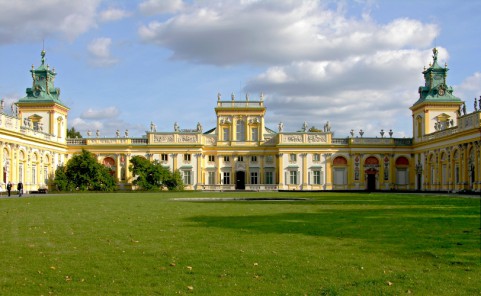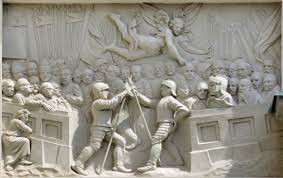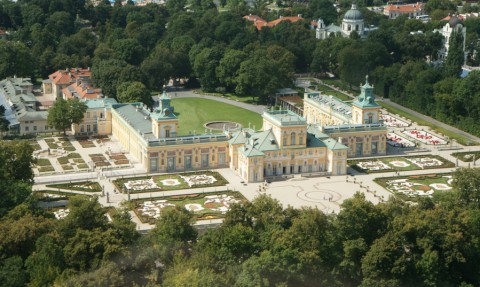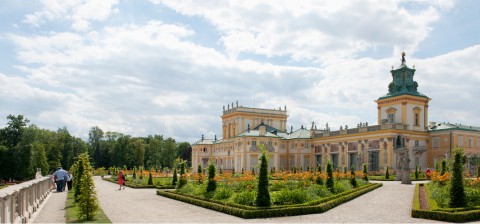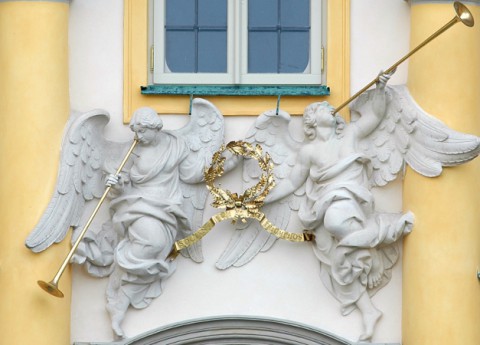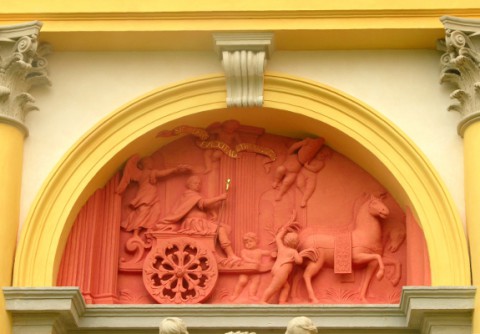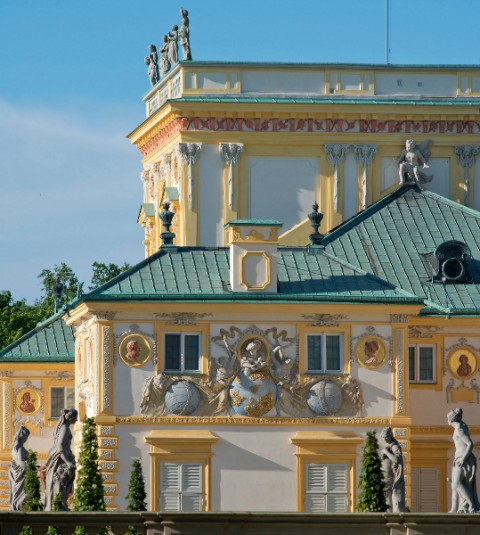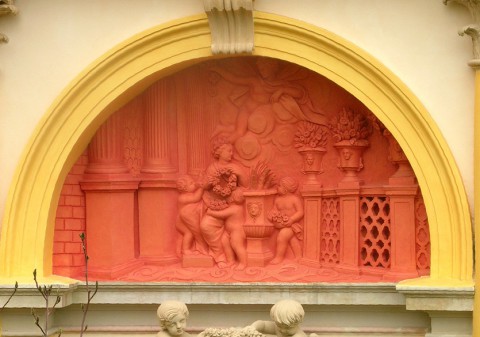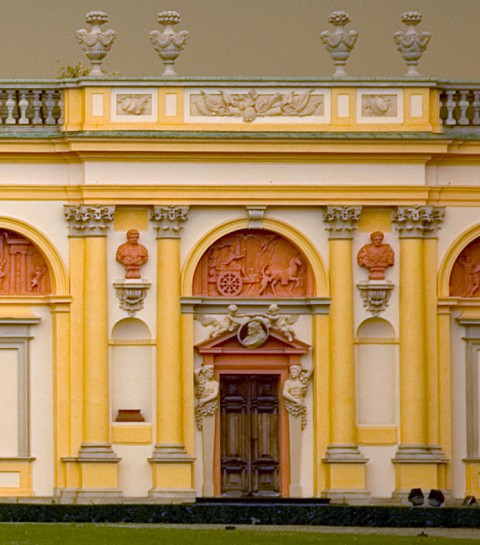Wilanów residence – introduction to your visit
Diversity of motives and inspirations identifiable in the Wilanów residence today results to a large extent from King Jan III Sobieski’s erudition. His personality exerted an impact not only on the rich content of the programme and the ideas associated with the place, but equally on the perception of the residence by the following generations. Wilanów became, and has remained to this day, a true Monumentum Sobiescianum, i.e. a monument to the great monarch’s glory and his outstanding personality.
The powerful relation between the Wilanów residence and its creator, Jan Sobieski, stems from three facts. Firstly, the residence was raised from its foundations, allowing the monarch to avoid any previous landscaping-related limitations. Secondly, Jan III died in one of the Wilanów Palace rooms. Thirdly and perhaps most importantly, King Jan III’s epoch – its shortcomings outshined by the spectacular victory in the Battle of Vienna (1683) – is perceived as the closing chapter of the glorious history of the powerful Polish-Lithuanian Commonwealth. The colourful and original culture of one of the largest states in contemporary Europe found its splendid representative in King Jan III. In the darker periods following Sobieski’s death, Wilanów exuded splendour of his unequalled fame, the gilded shields in the palace façade ceaselessly reflecting the lustre of past triumphs.
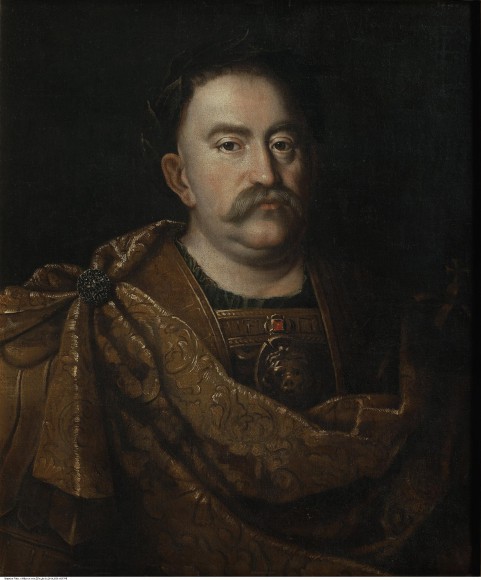
In order to comprehend the main concept behind Wilanów one must therefore first of all get acquainted with the residence founder. A nobleman born in the Ruthenian part of the Polish Crown (today’s Ukraine) and son of Jakub Sobieski, the prime of contemporary lay senators, Jan was being prepared for the public service from his early childhood. His formation was dominated by two factors; on the one hand it was the knightly ethos of his predecessors, cultivated by his mother Teofila, and on the other, Jan’s education commenced in Cracow and completed during his travel through Europe, which helped the future king to get familiarized with various models of government, war tactics as well as foreign art and culture. Already at an early age was Jan introduced to battlefield and military service and with time he would become a regular and eager warrior. Jan’s adulthood coincided with particularly turbulent times; he took part in war campaigns against Sweden, Turkey and Moscow, against the Tartars and the Cossacks, and was eventually appointed Grand Hetman of the Crown, assuming the highest military rank. At the same time he held the office of the Grand Marshal of the Crown, which meant his promotion to the circle of prime senators in the Commonwealth. Thus, Jan Sobieski became one of the most influential personages in the state. The royal throne, which he ascended in 1674, crowned his impressive and high-flying career.
The elective monarchy system of the contemporary Polish-Lithuanian Commonwealth assumed the king’s election by the nobles. Candidates for the throne originated from both foreign courts and local aristocracy. The election of Jan Sobieski resulted first and foremost from his successful military career, as only a few months preceding his enthronement Sobieski achieved a spectacular victory over the Ottoman Empire forces in the Battle of Chocim [Khotyn]. Following the coronation in 1676, the Royal Castle in Warsaw became the official seat of King Jan III. One of the most mobile of all Polish rulers, Sobieski resided in the capital city while frequently visiting his residences located in Ruthenia, of which the main was the Sobieski family’s hearth in Żółkiew [Zhovkva]. As he also intended to raise a private residence in the vicinity of Warsaw, the monarch purchased a small village named Milanów, located along the main route leading to Warsaw, which featured the foundations of a stone manor house and a parish church.
The Baroque residence was constructed in stages. Initially, Jan III raised a rather modest manor house, corresponding with a landowner’s rather than a monarch’s abode. The key expansion of the building took place after the victorious Battle of Vienna fought in 1683, when the commander-in-chief of Christian forces, Sobieski defeated powerful Turkish troops. The said victory inspired artists to create miscellaneous works including portraits, medals, prints and literary works in praise of the Polish king. It was also at that time that the royal residence was extended, assuming the entre cour et jardin (lit. between courtyard and garden) architectural premise, which combined features of a classic Polish manor house with elements typical of modern Italian villas and French palaces. The change of the village name from Milanów to Villa Nova, replaced later by the Polish “Wilanów”, proves beyond doubt that the residence under construction was inspired by patterns taken from the European culture, both Baroque and ancient.

The unique ideological programme of the Wilanów residence was inspired by Jan Sobieski’s remarkable personality and a specific political and international situation, which overlapped with his reign. An elective king, chosen by the nobles, Sobieski had to respect their opinion and push through his own ideas cautiously to avoid accusations of being an absolute ruler. He had no choice but to accept, or at least to put up with, the nobles’ arrogance and their opposition to the royal authority. Moreover, to had take into account the growing power of the neighbouring states. Consequently, the decorative and ideological programme realized in Wilanów, founded on multiple meanings and allusions, remains highly subtle. We still find it challenging to decode all the implicit meanings of the programme, which leaves room for ever new and fascinating interpretations. A lot of credit for that goes – let us stress it again – to Jan Sobieski, a book lover with avid passion for arts and sciences, who held scholarly disputes with influential people at his court.
After the triumphal victory in the Battle of Vienna, Jan III’s main objectives were to strengthen the international position of the Commonwealth, to regain the territories seized by the Ottoman Empire and to secure the throne for his eldest son Jakub Ludwik. As the latter objective stood in contradiction with the local electoral system, its successful implementation called for special measures. The palace façade from the side of the courtyard, i.e. the one most exposed to viewers, assumed an official, festive, almost temple-like character, its iconographic triumphant programme being focused on the royal couple's virtues, merits and duties. The façade from the side of the garden, accessible to fewer visitors, conveyed more subtle messages of less obvious interpretation. On careful analysis however, it reveals the prophecy of the Commonwealth’s glorious future secure under the Sobieskis’ reign.
The Wilanów Palace can therefore be viewed as an expression of the great king’s political testament. The figures of Famae above the main entrance, accompanied by the inscription Sociant cum pace triumphos (Triumphs bring forth peace), reveal the ultimate goal of all the king’s military engagements; the said maxim proclaims the concept of a “just war”, perceived as an Old Polish requirement to protect the state borders and to render service to the homeland and its allies. It also reveals the monarch’s conviction about the utmost value of peace, which ought to conclude all military conflicts and to remain the priority of all political activities. In view of that, it is the more interesting that bas-reliefs in the attics, representing Sobieski’s triumphal expeditions against units of armed Tartars (1672) and in the Battle of Chocim [Khotyn] (1673), are crowned with images of the royal election (1674) and the Peace Treaty of Żurawno (1676). Their dominating elements allude to the concept of reconciliation, depicting a gathering of nobility in the election field as well as the Poles and the Turks near Żurawno. The set of bas-reliefs is followed by images of the Battle of Vienna (1683) and the Battle of Parkany (1683). Jan III’s endeavours were fulfilled only 3 years after his death, when perpetual peace with the Ottoman Empire was finally concluded in 1699.

The monarch’s symbolic safeguarding of the state is expressed by the golden shields held by putti and accompanied by the inscription taken from the Old Testament Refulsit sol in clypeis [The sun shone upon the shields]. The motif of the shield alludes to the Sobieski family’s coat of arms, its smooth surface symbolizing the king’s purity and virtues, translating into the state’s development and prosperity. The shield is also visible in the palace façade from the side of the garden, where it provides shelter to the Eagle and the Pahonia coats of arms, i.e. the emblematic representations of the Polish-Lithuanian Commonwealth.
The palace façade from the side of the courtyard contains another depiction of Jan III, this time as a triumpher in a chariot. His escutcheon, lifted to the sky by putti, is adorned with the inscription Sic ardens evexit ad aethera virtus [Thus ardour lifted virtue in expanse]. Interestingly, Jan Sobieski did receive truly celestial fame, when the well-known astronomer Johannes Hevelius named his newly-discovered constellation Scutum Sobiescianum (Sobieski’s Shield). The constellation comprised 7 stars, symbolizing the contemporary number of the Sobieski family members (in 1684), i.e. Jan and Marie Casimire with their five offspring: Jakub, Teresa, Aleksander, Konstanty and Jan.
Plans of the royal court assumed that the Sobieskis would become the successive royal dynasty. Their prolonged reign would secure the mythological golden age, as symbolically represented in the southern part of the garden façade by Saturnus assuming power, holding a fabric with a sundial. The fortunate prophecy is proclaimed by two Sibyls represented in medallions. The composition seems to suggest that all the efforts made by Jan III, who had led the Commonwealth through a period of wars and confusion, would one day bear fruit during the reign of the king’s eldest son Jakub Ludwik. Only then would the country and its people enjoy the long sought-after peace and prosperity. The association of the palace with the entire state is clearly visible in the garden façade. Sculptures in niches found in the northern part of the façade personify different lands of the Commonwealth. The set representation was initially planned to be continued in the southern part of the façade, but the project was never completed.
Indeed, the Wilanów residence is more than a symbolic representation of the state and a prophetic image of its glorious future. It is also a veritable microcosm subordinated to the laws of nature, which regulate biological cycles and the human life. A mysterious composition on the northern side of the garden façade, which features Death plucking off Cupid’s wings, is complemented by the sundial, fitted in the southern elevation. The interweaving opposites of day and night, the beginning and the end, so typical of the Baroque culture, echo the spirituality and the dramatic events of Sobieski’s era.
The palace functioned as the centre, both ideological and administrative, of the aforementioned microcosm. Its adjacent gardens provided an aesthetic and material extension of the palace apartments, followed further up by the area of a home farm with animals, functional gardens and a hunting area. In line with the typically Baroque principal of the dominant feature regulating the exact location of specific elements, the East-West axis was emphasized, passing from the Wilanów fields through the forefield and the courtyard all the way to the other side of the Wilanów Lake. The main result of the outlined axis was the palace division into the southern part, housing Jan III’s apartment, and the northern part, home to Marie Casimire’s apartment. Decorations of the façades and the interiors respect the said division and complement each other with intertwining male and female elements. This interplay is traceable in the set of attic sculptures, the bas-reliefs ornamenting the archivolts of arches and also in decorations of the palace antechambers and bedrooms. The role of the queen is best summarized in the frequent apparition of Eos-Aurora, represented in the palace interior decorations. Preceding the solar chariot of Apollo (symbolizing the king), Eos-Aurora foretells the arrival of splendour.
The complementation of different elements and the achievement of their sublime harmony is also visible in the set of plafond paintings depicting the four seasons, which decorate the King’s and the Queen’s Antechambers and Bedrooms. Assigned to the king, the Winter (in the Antechamber) and the Summer (in the Bedroom) correspond with the Autumn and the Spring, decorating the Queen’s Antechamber and Bedroom respectively. A similar correspondence is found in the decoration of the triumphal arches in the façade. The southern side is dedicated to the king’s virtue of valour (the ancient Virtus heroica), represented by Jan III’s triumphant entry and a cavalcade of prisoners of wars. The northern side focuses on the queen’s beauty (the ancient Venustas), conveyed by Horae on a meadow, Zephyrus with Flora and Arion riding a dolphin.
The repertoire of the presented motifs, drawing on the Christian tradition and the legacy of Greek and Roman antiquity, proves beyond doubt that the contemporary Polish-Lithuanian Commonwealth was deeply enrooted in ancient culture at large. As confirmed by the inscription Quod vetus urbs coluit / nunc nova villa tenet [What the ancient city cultivated / the new villa possesses] inscribed in the palace façade, the world of ancient Rome proves particularly helpful in the correct interpretation of the Wilanów residence decorations and the meanings they communicate. The above Latin ”declaration” indicates unambiguously the source of Sobieski's political concepts and artistic ideas. It was ancient Rome which “discovered” the triumphal arch incorporated into the Wilanów Palace façade, thus emphasizing the decorations meant to proclaim the virtues of both the king and the queen. The ideal of the manorial lifestyle in perfect harmony with nature constitutes one more legacy of the ancient Rome, wherein warriors would be granted land to settle on and cultivate in recognition for their dedicated military service. In view of that it is hardly surprising that the palace façades and interiors feature representations of figures known from Antiquity, from Caesars through heroes, gods and goddesses, to Muses crowning the palace belvedere. Indeed, Sobieski perceived himself as a Roman triumpher, oft-times represented with a laurel wreath on his head. Apart from providing favourable models, convenient allegories and lists of deities that one could aspire to, the legacy of ancient Rome specified duties of both the ruler and the ruled. The 17th-century Polish-Lithuanian Commonwealth was the realm of a noble society, whose descendent Jan III Sobieski was after all. The antique culture functioned as the universal language of concepts easily comprehensible to the king’s contemporaries and as such, it provides today the key to the proper interpretation of messages conveyed by his residence.
Following Jan III Sobieski’s death in 1696 the palace was inherited by the king’s sons, Aleksander and Konstanty. However, the inheritors failed to properly look after their late father’s estate and, to make matter worse, the so-called Northern War, fought at the beginning of the 18th century, created highly unfavourable conditions for safeguarding the property. Fortunately, the neglected royal residence was purchased in 1720 by Elżbieta Sieniawska, a powerful, ambitious and energetic aristocrat, wife of hetman Sieniawski. Thanks to her efforts the palace regained its formal splendour. By adding side wings to the main corpus of the building, the new owner enclosed the courtyard, divided now into the stately and the utility parts. It was on Sieniawska’s initiative that the stage design-like composition of the palace, with its chiaroscuro façades, the subdivided main building and the multitude of meaningful decorations, became finally complete.
suggested

History of the museum
The museum at the Wilanów palace is the oldest Polish museum of art. It was established in 1805, on the …

History of the collection
Already Jan III collected works of art and exquisite objects of everyday use. However, only a fraction of his collection …

History of the palace
The Wilanów Palace was established at the behest of King Jan III as his suburban summer residence. The building was …

History of the park
In the times of Jan III, construction work on the Wilanów Palace took place concurrently with the establishment of beautiful …

Morysin natural reserve - the place where nature and history meet
To the North-East of the Wilanów Palace, on the other side of the Vistula oxbow lake, between the Sobieski Channel …

King Jan III Sobieski Palace – building plan
The “King Jan III Sobieski Palace – building plan” was translated into English as a part of the “The revitalisation …


